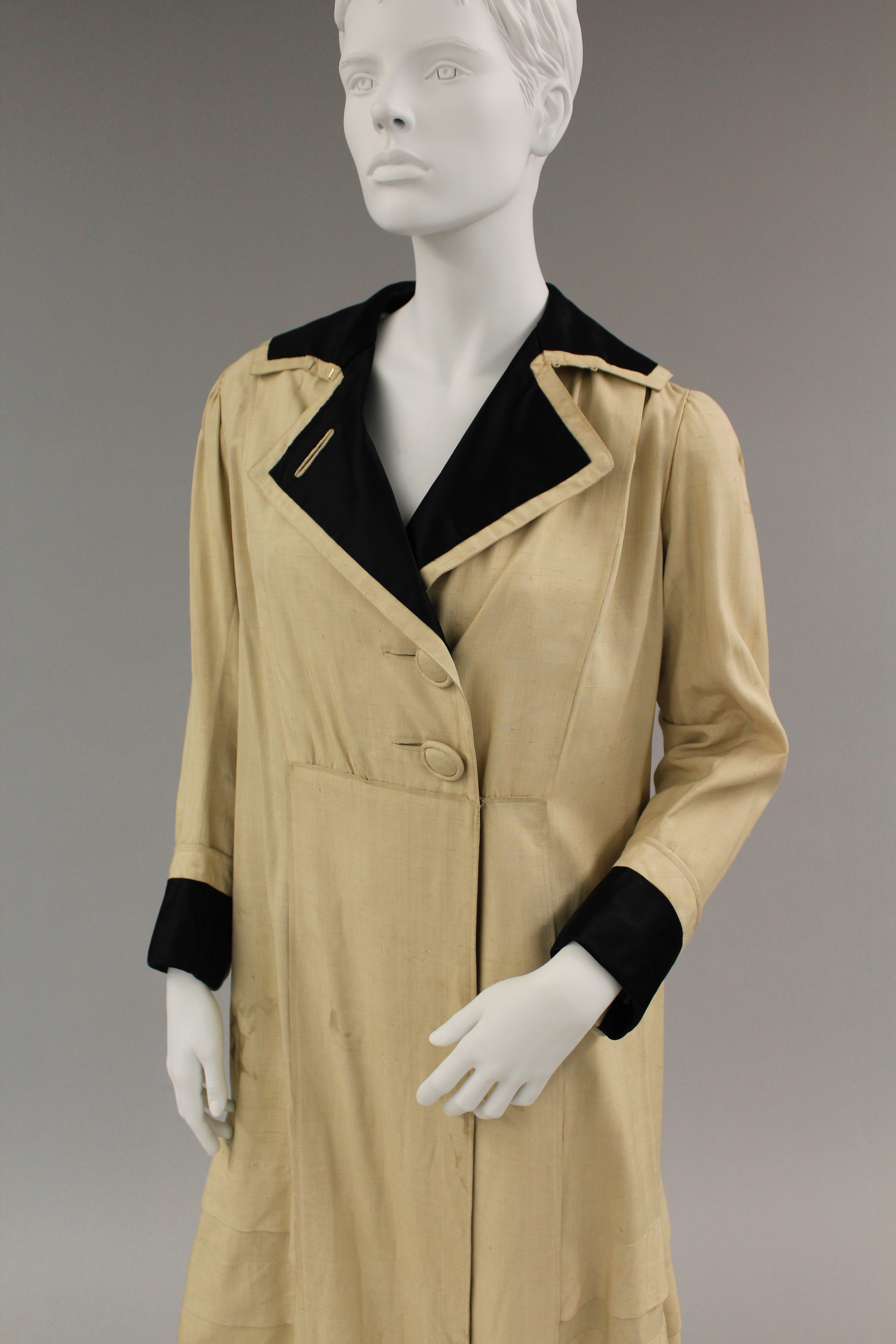Riding
Riding has an ancient context specifically relating to horseback riding, or riding of similar animals, and has modernly evolved to include riding in a motorized vehicle or within a public transport system like a train, car, motorcycle, or bus. We interpret riding differently from rolling because the function of riding involves mechanized force or strength derived from a body other than a human one. Riding is a shared transit experience, and thus the garments or images selected for this category relate specifically to the kinds of relationships that pertain to a certain specificity in riding; including garments that expand to make space for the female body, human accessories that can serve as a bandage for a horse, and dusters made for keeping the velocity of road debris kicked up while driving off the body.

Military Uniform
Military Uniform
Date: World War l
Medium: Photograph
Image Courtesy of American Red Cross
Description: Women significantly participated in World War l by driving the Motor Corps voluntarily. Motor Corps was used for different purposes, including delivering supplies, transporting nurses and workers to their posts, sick and wounded people to the hospitals. Due to the Motor Corps' important role, only women with extensive training could enroll in the Red Cross. At that time, women’s uniforms became available in all parts of women’s war efforts, including the Red Cross. However, women’s uniform was influenced by men’s uniform. The change from traditional dressing to uniforms was basically a matter of practicality. Adopting uniforms offered women respect, self-confidence, self-worth, validity, suppressing gender distinctions, and importantly the right to vote in 1920.

Saddle Blanket
Date: ca.1983
Medium: Leather, cotton
Image Courtesy of Donald C. & Elizabeth M. Dickinson Research Center, National Cowboy & Western Heritage Museum
Description: Saddles are a supportive structure fastened to a horse's back by a girth and help keep the moisture off of the horseback and prevent potential problems related to the horse back-body. Till 1850, people used animal hides to make saddle blankets. Later, saddle blankets became available with fantastic decorative techniques. Also, saddle designers are considering the wearer's body protection from accidents or other natural elements.

Motoring Duster
Date: ca.1920
Medium:
Credit: Balch Collection
Description: This long, tan motoring duster with matching covered buttons at center front, exposed satin collar, cuffs, and decorative pleats at the knee, worn while riding early automobiles. Long duster coats and goggles became available in the world of women’s fashion clothing in 1900, mainly to protect women’s body and their clothes while traveling in the very first version of automobiles, which did not have a windscreen, side doors, and roofs. Its emergence is a symbol of non-gender-based activity that caused the rise of female motorists in that era. The design is portraying the balance between masculine technology of motoring and women.




Auto cap with attached goggles
Date:1908-1914
Medium: Wool, Plastic goggles, Leather lining
Credit: Dr. Farnham H. Shaw, Willsboro, Pennsylvania
This olive-green wool auto cap is dated to be from the early 1900s. The cap's side and back extend low enough to cover both the neck and the ears when being worn. Inside, there is the visible remnant of a manufacturing label; however, it can no longer be read due to degradation and fading. This piece is unique in that it has a built-in pair of goggles. The goggles, a flexible yellow plastic, are sewn around the hat’s bill's interior edge. The wearer of this cap was the father of Cornell alumni and former professor Dr. Mary Shaw Ryan. Dr. Ryan’s father, who resided in Willsboro, PA, was one of the town’s first residents to own an automobile and would wear this while driving.
Personal Space Dress
Date: 2014
Medium: Performative garment
Designer: Kathleen McDermott
Image Courtesy of Kathleen McDermott
Description: Artist Kathleen McDermott created this dress as a part of Urban Armor, to address the needs of women who are at risk of harassment in public, specifically while riding the bus, metro, and existing in crowded places. Sensors in the front and back of the dress detect when a presence is too close to the wearer. When the presence is detected, motors are activated to open up and expand the skirt of the dress and create more space around the wearer. The dress closes when the area around it is detected as unoccupied. The Personal Space dress opens an opportunity for women to take control of their environment, and have some fun while using public transportation.



Equestrian Riding Habit
Date: 1931/1932
Designer/Manufacturer/Retailer:
Place of Origin:
Used by: Gertrude Heim Remey
Source: Remey, Charles Mason
Description: This formal English riding habit was used by Gertrude Heim Remey during the 1920s. It is comprised of a raw silk checkered jacket, tan gabardine breeches, brown derby, knee-high boots, and white cotton blouse complete with stock tie and pin. As Remey was a wealthy socialite, this beautifully intact ensemble is representative of high-end equestrian fashion at the time of its manufacture. This ensemble, as well as the rest of Remey’s wardrobe, was donated to CF+TC by her husband Chares Mason Remey after her death in 1932. An extensive history of this ensemble appears on the Cornell Fashion + Textile Collection’s blog, written by Karen Steffy, Graduate Field Assistant in the Fiber Science and Apparel Design Department at Cornell University.
http://blogs.cornell.edu/cornellcostume/2018/03/21/riding-apparel-then-and-now/